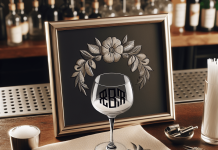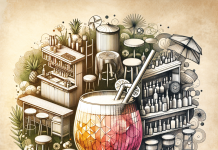Step into the world of cocktail trends and prepare to have your taste buds tantalized. From seasonal cocktails bursting with fresh fruits and herbs to the mind-bending techniques of molecular mixology, and the harmonious blend of nature and spirits in botanical cocktails, there is no shortage of exciting and innovative creations to explore. So grab a glass, sit back, and let us take you on a journey through the ever-evolving landscape of the cocktail scene.
Seasonal Cocktails
Definition and Concept
Seasonal cocktails are drinks that are specifically created to highlight and incorporate the flavors and ingredients that are readily available during a particular season. These cocktails are designed to take advantage of the freshest ingredients, whether it’s the vibrant fruits of summer or the warm spices of fall. The concept behind seasonal cocktails is to create a drink that not only tastes delicious but also evokes the spirit and essence of the season.
Benefits of Seasonal Cocktails
There are several benefits to embracing seasonal cocktails. First and foremost, they provide an opportunity to explore and celebrate the unique flavors and ingredients that each season has to offer. By using fresh, in-season produce, these cocktails are inherently more vibrant and flavorful. Additionally, seasonal cocktails allow us to connect with nature and the changing seasons, creating a sense of anticipation and excitement with every sip.
Furthermore, seasonal cocktails are a reflection of sustainability and supporting local farmers. By utilizing ingredients that are in season, we are reducing our carbon footprint and supporting the local economy. Seasonal cocktails also promote creativity and experimentation in mixology, as bartenders are constantly challenged to come up with new and exciting drink recipes that showcase the best of what each season has to offer.
Popular Seasonal Ingredients
Each season brings a unique array of ingredients that are perfect for crafting seasonal cocktails. In the spring, refreshing and bright flavors take center stage, with ingredients like berries, citrus fruits, and herbs. Summer is the time for exotic fruits, such as watermelon and pineapple, as well as tropical flavors like coconut and passionfruit. Fall brings a bounty of warming spices like cinnamon and nutmeg, along with pears, apples, and cranberries. Finally, winter calls for rich, indulgent flavors like chocolate, spices, and winter citrus.
Mixologists’ Seasonal Inspirations
Mixologists draw inspiration from a variety of sources when creating seasonal cocktails. They often look to nature and the changing seasons for flavor combinations and ingredients that pair well together. For example, during the spring, mixologists may be inspired by the blossoming flowers and fresh herbs that signal the arrival of warmer weather. In the fall, they may take cues from the colors and flavors of harvest season, incorporating apples, pumpkins, and warm spices into their cocktails.
Additionally, mixologists may find inspiration in culinary trends and popular dishes of the season. By borrowing flavor profiles and techniques from the kitchen, they can create cocktails that complement and enhance the dining experience. From infusing cocktails with smoky flavors to incorporating unique botanical elements, mixologists constantly push the boundaries of creativity in order to create innovative and delightful seasonal drinks.
Techniques for Creating Seasonal Cocktails
Creating seasonal cocktails requires a combination of skill, creativity, and an understanding of flavor profiles. Mixologists use a variety of techniques to showcase seasonal ingredients and capture the essence of a particular season. One popular technique is muddling, which involves gently crushing fruits or herbs to release their oils and flavors. This is commonly used to infuse cocktails with the vibrant flavors of summer berries or the fresh aroma of mint.
Another technique used in seasonal cocktail creation is infusion. Mixologists may infuse spirits with seasonal ingredients, such as citrus peels or spices, to add depth and complexity to their cocktails. This allows for a more nuanced flavor profile and creates a unique drinking experience. Additionally, mixologists may experiment with various garnishes, such as edible flowers or seasonal herbs, to add visual appeal and enhance the overall flavor profile of the cocktail.
By utilizing these techniques and staying attuned to the flavors and ingredients of each season, mixologists are able to create irresistible seasonal cocktails that capture the essence of the changing seasons.
Molecular Mixology
Introduction to Molecular Mixology
Molecular mixology is an innovative approach to cocktail-making that combines science, art, and creativity. It involves using scientific techniques and tools to transform the texture, appearance, and taste of cocktails. This avant-garde approach to mixology has gained popularity in recent years for its ability to create visually stunning and unique drinks that push the boundaries of traditional cocktail-making.
Key Techniques and Tools
Molecular mixology relies on a range of techniques and tools to create its signature effects. One common technique is spherification, which involves transforming liquids into edible spheres. By using an ingredient called sodium alginate and a calcium-rich solution, mixologists can create small, flavorful spheres that burst in the mouth, adding a surprising and delightful element to the drink.
Another popular technique used in molecular mixology is foaming. By using a whipping siphon or a blender, mixologists can create foams from various ingredients, such as fruit juices or spirits. These foams add a velvety texture and enhance the visual appeal of the cocktail.
Innovative Molecular Mixology Ingredients
Molecular mixology incorporates a range of innovative ingredients that help create its unique effects. One popular ingredient is liquid nitrogen, which is often used to rapidly freeze ingredients and create a dramatic smoky effect. This creates a visually stunning cocktail experience and adds an element of surprise and excitement.
Another ingredient commonly found in molecular mixology is agar-agar, a natural gelling agent derived from seaweed. Agar-agar allows mixologists to create solidified cocktails or gel-like textures, opening up endless possibilities for presentation and texture manipulation.
Fascinating Molecular Mixology Effects
Molecular mixology is known for its ability to create fascinating and unexpected effects in cocktails. One such effect is the creation of smoke or mist, which can be achieved through the use of dry ice or smoking guns. This adds a sensory element to the cocktail, immersing the drinker in an aromatic and visually captivating experience.
Another effect commonly used in molecular mixology is the creation of layered or suspended ingredients. By carefully controlling the density of different liquids, mixologists can create visually striking cocktails with distinct layers of flavor. This adds depth and complexity to the drinking experience, as each layer presents a different taste sensation.
Tips for Incorporating Molecular Mixology in Cocktails
Incorporating molecular mixology techniques into cocktails requires a balance between creativity and technique. It’s important to start with a good understanding of the basic principles of mixology before venturing into the world of molecular mixology. Experimentation and practice are key in order to achieve desired effects and create well-balanced and delicious cocktails.
Additionally, it’s important to remember that molecular mixology is not just about creating visually stunning drinks. The focus should always be on flavor and balance. The techniques and tools used in molecular mixology should enhance the overall drinking experience, rather than overshadowing the taste of the cocktail.
By combining traditional mixology skills with the innovative techniques of molecular mixology, bartenders can create visually stunning and delicious cocktails that leave a lasting impression on even the most discerning of drinkers.
Botanical Cocktails
Understanding Botanical Cocktails
Botanical cocktails are drinks that celebrate the flavors and aromas of various botanical ingredients, including herbs, flowers, and spices. These cocktails often incorporate fresh and dried botanicals to add depth and complexity to the drink. Botanical cocktails are known for their refreshing and vibrant flavors, as well as their ability to transport the drinker to a garden or a lush forest with every sip.
Selecting and Preparing Botanical Ingredients
The key to creating a successful botanical cocktail lies in the selection and preparation of botanical ingredients. Fresh herbs, such as mint, basil, and rosemary, should be carefully washed and gently muddled to release their essential oils. Dried botanicals, such as lavender or hibiscus, should be steeped in hot water to create flavorful infusions.
It’s important to choose high-quality botanical ingredients to ensure the best flavor and aroma in the final cocktail. Organic and locally sourced botanicals are often preferred, as they are believed to have a more pronounced flavor and a higher concentration of beneficial compounds.
Floral and Herbal Infusions
Infusing spirits with floral and herbal flavors is a common technique used in botanical cocktails. This involves soaking botanical ingredients in a base spirit, such as vodka or gin, to extract their essence. The result is a spirit infused with the delicate flavors of flowers and herbs, which can then be used as the base for a botanical cocktail.
Floral infusions, such as rose or elderflower, add a delicate and aromatic quality to cocktails, while herbal infusions, like thyme or sage, provide earthy and savory notes. These infusions can be used as a standalone ingredient or combined with other flavors to create a more complex and layered cocktail.
Creative Botanical Garnishes
Botanical cocktails often feature creative and visually stunning garnishes that enhance the overall drinking experience. For example, a sprig of fresh lavender or a delicate edible flower can add an elegant touch to a cocktail, while a twist of citrus peel can provide a burst of fragrance.
In addition to traditional garnishes, mixologists may also experiment with unconventional botanical elements. For example, a sprig of rosemary that has been lightly torched can release a fragrant aroma when placed on top of a smoky cocktail. This adds an element of surprise and creates a multisensory experience for the drinker.
Botanical Cocktails for Health and Wellness
Botanical cocktails not only offer delicious and refreshing flavors but also have the potential to provide health and wellness benefits. Many botanicals are known for their medicinal properties and can be incorporated into cocktails to provide a natural boost to the immune system or support digestion.
For example, cocktails made with ginger or chamomile can help soothe an upset stomach, while those infused with peppermint or lemon balm can provide a refreshing and energizing effect. By combining botanicals with other nourishing ingredients, such as fresh fruit juices or herbal teas, mixologists can create drinks that are not only enjoyable but also promote overall well-being.
Botanical cocktails offer a refreshing and vibrant drinking experience that celebrates the flavors and aromas of nature. With careful selection, preparation, and creative garnishing, mixologists can create botanical cocktails that not only taste incredible but also transport the drinker to a botanical wonderland with every sip.
Local and Sustainable Ingredients
The Embrace of Local and Sustainable Cocktail Culture
In recent years, there has been a growing trend in the cocktail industry towards using local and sustainable ingredients. This movement is driven by a desire to support local farmers and producers, as well as a commitment to environmental responsibility. By sourcing ingredients from nearby farms and utilizing sustainable practices, bartenders can create unique and authentic cocktails while minimizing their impact on the environment.
Benefits of Using Local and Sustainable Ingredients
There are several benefits to using local and sustainable ingredients in cocktails. First and foremost, it allows bartenders to showcase the flavors and terroir of a particular region. By using local produce, herbs, and spirits, bartenders can create cocktails that truly reflect the unique character of a specific locale. This not only adds a sense of place to the drink but also fosters a stronger connection between the consumer and the community.
Furthermore, using local and sustainable ingredients supports the local economy and helps small-scale farmers and producers thrive. By sourcing ingredients directly from local suppliers, bartenders can ensure that their ingredients are fresh and of the highest quality. This also reduces the carbon footprint associated with transporting ingredients over long distances, contributing to a more sustainable cocktail culture.
Showcasing Regional Flavors
Each region has its own unique flavors and ingredients that can be showcased through cocktails. For example, coastal regions may have access to fresh seafood and seaweed, which can be incorporated into innovative and refreshing cocktails. Inland regions may have an abundance of fruits, vegetables, and herbs that can be used to create vibrant and flavorful drinks.
By using local flavors and ingredients, bartenders can create cocktails that tell a story about the region and its culinary heritage. This not only creates a memorable drinking experience but also educates and engages the drinker, fostering a deeper appreciation for local ingredients and flavors.
Supporting Local Farmers and Producers
Using local and sustainable ingredients in cocktails helps support the local agricultural community. By sourcing ingredients from nearby farms and producers, bartenders contribute to the livelihood of local farmers and help sustain their businesses. This direct relationship between bartenders and farmers also encourages transparency and accountability in the supply chain, ensuring that the ingredients used in cocktails are of the highest quality and ethically sourced.
Additionally, supporting local farmers and producers promotes biodiversity and helps preserve traditional farming practices. By using heirloom or rare varieties of fruits and vegetables, bartenders can help protect and promote these unique and important agricultural resources. This adds a layer of cultural significance to the cocktail, as it becomes a vehicle for preserving and celebrating local food traditions.
Creating Unique and Authentic Cocktails
Using local and sustainable ingredients in cocktails allows bartenders to create unique and authentic drinks that cannot be replicated elsewhere. By working with the flavors and ingredients of their specific region, bartenders can showcase their creativity and expertise, resulting in cocktails that are truly one-of-a-kind.
The use of local and sustainable ingredients also encourages bartenders to think outside the box and experiment with unconventional flavor combinations. By embracing the diversity of local produce and embracing sustainable practices, bartenders can create cocktails that surprise and delight the palate.
By embracing local and sustainable ingredients, bartenders can create cocktails that not only taste amazing but also have a positive impact on the environment and the local community. This movement towards sustainability and supporting local farmers is an exciting development that is shaping the future of cocktail culture.
Craft Ice
The Importance of Ice in Cocktails
Ice is an essential ingredient in cocktails, playing a crucial role in temperature control, dilution, and texture. It not only chills the drink but also helps to mellow and balance the flavors. The quality of ice used can greatly impact the overall drinking experience, and craft ice has emerged as a trend in the cocktail industry for its ability to enhance aesthetics and elevate the cocktail experience.
Artisan Ice – A Craft Cocktail Essential
Craft ice refers to ice that is carefully crafted and shaped to enhance the overall presentation and flavor of a cocktail. It is often larger and denser than traditional ice cubes, allowing for slower melting and less dilution. Craft ice comes in various shapes, including spheres, cubes, and even custom-designed shapes that can be tailored to the specific cocktail being served.
Craft ice is typically made using purified water to ensure clarity and purity. The freezing process is closely monitored to prevent the formation of air bubbles or impurities, resulting in ice that is crystal clear and visually appealing. This attention to detail and craftsmanship adds an elevated and sophisticated element to the cocktail experience.
Different Types and Shapes of Craft Ice
Craft ice comes in a variety of shapes and sizes, each designed to enhance the drinking experience in its own unique way. One popular shape is the large ice sphere, which provides a striking visual element while melting slowly and evenly. The slow melt rate of a sphere ensures that the cocktail remains chilled without becoming overly diluted.
Another common shape of craft ice is the oversized cube. These larger cubes have a lower surface area-to-volume ratio than traditional ice cubes, resulting in slower melting and less dilution. They are often used in spirit-forward cocktails, where maintaining the integrity of the drink is crucial.
In addition to these traditional shapes, craft ice can also take on custom-designed forms that are tailored to suit a particular cocktail or bar’s aesthetic. These custom-shaped ice cubes can add a whimsical or personalized touch to cocktails and further enhance the overall presentation.
Enhancing Aesthetic Appeal and Cocktail Experience
Craft ice goes beyond functionality and serves as a visual centerpiece in cocktails. The crystal-clear clarity and precise shapes of craft ice elevate the overall aesthetic appeal of a drink, making it visually striking and Instagram-worthy. This attention to detail and presentation adds a sense of luxury and sophistication to the cocktail experience, turning a simple drink into a work of art.
Furthermore, craft ice reduces unwanted dilution in cocktails, allowing the drink to maintain its optimal flavor balance for a longer period. The slower melt rate of craft ice ensures that the cocktail remains cool without becoming excessively diluted, providing a more enjoyable and consistent drinking experience.
Where to Find or Make Craft Ice
Craft ice is becoming increasingly popular and can now be found at many high-end cocktail bars and establishments. These bars often have specialized equipment and dedicated ice programs to create their own craft ice in-house. This allows for a greater level of customization and control over the shape, clarity, and quality of the ice.
For those looking to make craft ice at home, there are various molds and trays available on the market that can produce different shapes and sizes of craft ice. These molds are often made from silicone or stainless steel, ensuring the ice is easy to release and maintain the desired shape. With a little practice and attention to detail, anyone can create their own craft ice at home and elevate their cocktail experience.
Craft ice offers a unique and visually stunning element to cocktails. Its slow melt rate, crystal-clear clarity, and precise shapes enhance the overall drinking experience, bringing an added level of sophistication and elegance to every sip.
Low-Alcohol and Non-Alcoholic Alternatives
Rise of Low-Alcohol and Non-Alcoholic Beverage Market
In recent years, there has been a significant rise in the popularity of low-alcohol and non-alcoholic beverages. This trend is driven by a growing interest in wellness, moderation, and seeking out alternatives to traditional alcoholic drinks. Low-alcohol and non-alcoholic cocktails, often referred to as “mocktails,” offer a sophisticated and flavorful experience without the intoxicating effects.
Benefits and Appeal of Low-Alcohol and Non-Alcoholic Cocktails
Low-alcohol and non-alcoholic cocktails provide a range of benefits and appeal to a diverse range of consumers. For those who choose to abstain from alcohol, non-alcoholic cocktails offer a way to participate in social gatherings and enjoy a sophisticated and flavorful beverage. These drinks can be just as enjoyable and indulgent as their alcoholic counterparts, without the negative effects of alcohol.
Low-alcohol cocktails, on the other hand, appeal to those who wish to enjoy a drink without the strong effects of alcohol. These drinks typically contain a lower percentage of alcohol, allowing for a more controlled and moderate drinking experience. Low-alcohol cocktails offer the opportunity to savor the flavors and aromas of a cocktail without feeling the effects of excessive drinking.
Exploring Non-Alcoholic Spirits and Mixers
The rise of the low-alcohol and non-alcoholic beverage market has led to an increase in the availability and variety of non-alcoholic spirits and mixers. These products are designed to mimic the flavors and characteristics of their alcoholic counterparts, allowing for the creation of complex and sophisticated mocktails.
Non-alcoholic spirits, such as alcohol-free gin, vodka, and whiskey alternatives, provide a base for creating non-alcoholic cocktails that closely resemble traditional cocktails. These spirits are often made by distilling or macerating botanicals, herbs, and spices to create complex flavor profiles without the alcohol content.
Non-alcoholic mixers, such as flavored syrups and bitters, are also widely available and can be used to add depth and complexity to non-alcoholic cocktails. These mixers allow bartenders to replicate the flavors of classic cocktails, such as the Negroni or the Old Fashioned, without the alcohol.
Tools and Techniques for Crafting Flavorful Non-Alcoholic Drinks
Crafting flavorful non-alcoholic drinks requires the same level of skill, technique, and attention to detail as traditional cocktails. Mixologists can utilize a range of tools and techniques to create delicious and complex mocktails.
Muddling fresh fruits and herbs is a popular technique used to release their flavors and aromas in non-alcoholic drinks. This process involves gently crushing the ingredients to extract their essential oils, resulting in a vibrant and flavorful base for the mocktail.
Using high-quality mixers, syrups, and bitters is key to crafting flavorful non-alcoholic drinks. These ingredients can provide a range of flavors, from sweet and fruity to bitter and aromatic, allowing mixologists to personalize the mocktail to suit individual preferences.
Garnishing is also an important aspect of non-alcoholic cocktail creation. Fresh herbs, citrus twists, and edible flowers can add a visually appealing and aromatic touch to mocktails. These garnishes not only enhance the overall presentation but also contribute to the overall flavor profile of the drink.
Meeting the Demand for Zero-Proof Options
As the demand for low-alcohol and non-alcoholic options continues to grow, more and more bars and restaurants are placing an emphasis on creating innovative and delicious mocktail menus. This shift in the industry is driven by a desire to provide inclusive experiences for all guests, regardless of their alcohol preferences.
Bartenders are increasingly showcasing their creativity and mixology skills in the world of non-alcoholic drinks. They experiment with unique flavor combinations, exciting garnishes, and innovative techniques to create mocktails that stand on their own as flavorful and enjoyable beverages.
The rise of low-alcohol and non-alcoholic cocktails is an exciting development in the cocktail industry, reflecting a shift in consumer preferences towards wellness and moderation. Whether it’s a non-alcoholic spirit or a perfectly crafted mocktail, these options provide a sophisticated and flavorful experience for all who choose to partake.









































